Paul's Basic Guide to 16mm
Projectors
From time to time people ask me "What projector should I get." Of
course, the answer is "It depends." In this page, I will try to
give an overview of the different kinds of projectors that were made
over the years. I will not attempt to give a detailed comparison
of different models. Of course, all the opinions expressed in
this page are probably wrong anyway.
Light sources
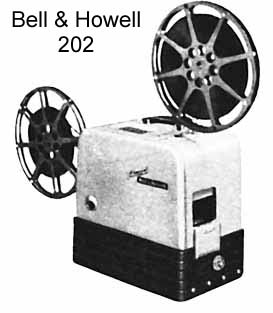
Conventional tubular lamps were standard until the early 1970s.
At one time these were called "Mazda" lamps, which was a trademark for
tungsten filament lamps. There are about 4.5 to 6 inches tall,
and typically range from 300 to 1200 watts. 750 watts was the
most common in 16mm projection.
Tungsten-halogen lamps with dichroic reflectors permanently attached to
the lamp became standard in the early 1970s. These were a big
improvement in efficiency. The mirror collects most of the light
that would be wasted in the lamphouse and focuses it on the film.
These usually operate on low voltages, permitting a smaller and more
efficient filament. The halogen cycle extends lamp life without
darkening of the bulb. A 250 W lamp of this type will provide
brighter screen illumination than a 1000 W conventional lamp. The
dichroic reflector reflects visible light but passes infrared, reducing
the heat on the film.
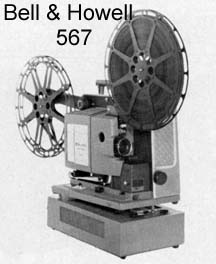
MARC and Gemini are metal arc lamps, which are much brighter than
incandescent lamps. I don't know what gas they used.
Projectors for these usually required a separate power supply, though
some had them built in. They have the disadvantage of short lamp
life, lasting about 25 hours, and darkening with age. This
wouldn't be so bad if they weren't expensive and hard to find.
Xenon arc lamps are significantly brighter than other types. A
metal anode and cathode are inside a quartz bulb filled with xenon
gas. Usually a separate power supply is required. The lamps
are under high pressure, and require special handling. Protective gear
must be worn when replacing these lamps. They are use with a
large ellipsoidal reflector. They require plenty of
air-cooling. The lamps are quite expensive, but last up to 2000
hours, so they don't cost much more than tungsten halogen lamps per
hour of operation. Sometimes external xenon lamphouses were
attached to conventional 16mm projector heads.
Carbon arc lamps were used on a few high intensity 16mm
projectors. These predated the xenon models. An arc is
formed between 2 carbon rods. A motor drives the rods as they are
consumed. Rods must be replaced after every reel or two.
Forced ventilation to the outside is necessary. These are
relatively rare.
Classes of Projectors
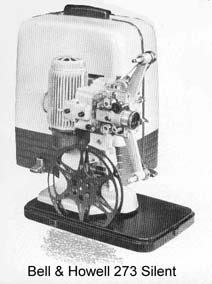
Toy projectors were made mostly in the 1930s and 1940s, and were sold
for use with silent shorts and cartoons. These were made by
companies such as Excel, Keystone and Kodak. They would use
household or automobile lamps, and weren't very bright. They are quite
rough on film and should be used as shelf ornaments.
Silent projectors were sold to amateurs who didn't need to project
sound movies. Some of the better models, such as those from Bell
& Howell, Eastman Kodak and Ampro were based on the same mechanisms
used in their sound models. Silent projectors usually have capacity for
400-foot reels.
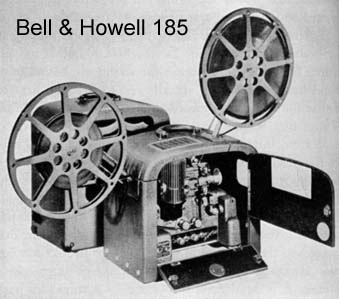
Classic sound projectors would include those using conventional tubular
lamps, and vacuum tube (valve) amplifiers, and manual threading.
In this group I would include the Bell and Howell 100-399 series, the
Eastman Kodak without halogen lamps, the Ampros, the RCA 400, the
various JAN models, along with some of the odder projectors such as the
Movie-Mite, Revere and Natco. The B&H 500 series would have
to fit here, but it is a transitional model. Projectors in this
category usually have capacity for 2000-foot reels. These
projectors usually aren't as bright as newer models. By now, most
of these need most of their capacitors to be replaced.
Modern portable sound projectors would include those with solid-state
amplifiers and tungsten-halogen lamps, and automatic threading or slot
loading. Some of these are manual threading. In this group
I would include the Bell & Howell 1500 and 2500 series, Eiki, Elmo,
Hokushin, Eastman Kodak with halogen lamp, and the B&H and Eastman
projectors made by Eiki and Elmo. The vast majority of projectors
in regular use would fall into this category. Projectors in this
category usually have capacity for 2000 foot reels.
Portable high-intensity projectors would include those using the
MARC/Gemini lamps, xenon lamps, or even carbon arc. Carbon arc
projectors were made in the 1950s by Bell & Howell, RCA, Ampro and
others. Projectors using MARC/Gemini lamps were made by B&H,
Eastman Kodak and others, mostly in the 1970s. Projectors using
xenon lamps were made by Eiki, Elmo, Hokushin and others, mostly from
the 1970s onward. There were also third party conversions of
various other projectors. Projectors in this category usually
have capacity for 2000 foot reels.
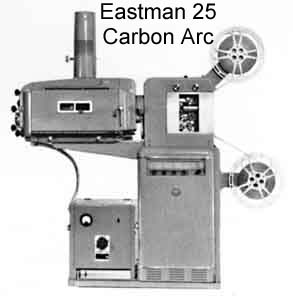
Professional projectors would include those that are intended to be
mounted on pedestals for permanent installations. These would generally
have xenon illumination, either from a built-in lamphouse or an
external lamphouse. The older projectors in this category could
have carbon arc lamphouses. The better models in this category
would use pull-downs of the geneva intermittent or similar type instead
of the standard claw shuttle. Projectors in this category usually
have capacity for 6000 foot reels.
Telecine projectors, also called film chain projectors are used for
broadcasting from film or recording film onto videotape. For the
NTSC television standard, portable versions use a 5 blade shutter and a
synchronous motor. Pedestal mount models have a true 3-2 pulldown
to accomplish the conversion from 24 FPS to 30 FPS interlaced. In
countries that use the PAL television standard, telecine projectors are
run at 25 FPS.
Special puropse projectors were made for various needs.
These include Time-and-motion study projectors with variable speeds for
slow motion analysis. Models were made by companies such as Kodak
and Bell & Howell. Companies such as L-W made versions based
on the Kodak, and Apollo made versions based on the Hokushin.
Dual-band projectors were made by companies such as Siemens to show
films that were in production with the sound track on a separate
magnetic film. There were also portable rear-projection units for
sales demonstration purposes.
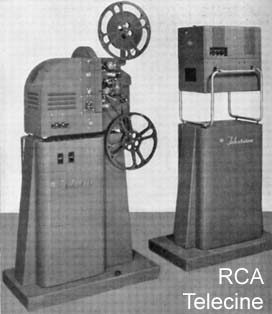
Threading Systems
Projectors typically use one of three threading systems: Manual
Threading, Self-Threading and Slot-Loading. Older projectors are
virtually all manual threading. Self threading became available
in the 1960s, and became dominant in the 1970s. Slot loading
became available in the late 1970s, and became popular in the
1980s. Manual threading projectors, when operated carefully can
be the safest on film. Unfortunately many of them do not have
automatic shut-off or automatic loop restorers, so a lost loop can
result in additional torn perforations and/or scratched film.
Inching knobs on some of these allow you to verify that the threading
is correct before turning on the motor. Self threaders are very
fussy about the condition of the leader. It is important not to
use leader that is shrunken, warped, splicy or has adhesive residue on
it. If the leader is not perfect, it will bunch up in the
projector and get pleated like an accordion bellows. Self
threaders usually have automatic loop restorers, and can be tolerant of
damaged film, once you get past the leader. The biggest drawback
is that it is difficult to unload a film in the middle. They are
easier to clean than slot loaders. Self threaders are often
maligned, but I have been using them for many years, running thousands
of films, and have never damaged a film as a result of the
projector. I have crumpled quite a few leaders that should have
been replaced before starting the film. They have the advantage
of being plentiful, and therefore, cheap. Slot loaders have
become very popular. They are quick and easy to thread, and are
tolerant of imperfect leaders. They are much easier than self
threaders, if you want to remove a film partway through. I will
usually grab a slot loader if I am previewing a film that I may not
want to watch all the way through. Film can be damaged by a slot
loader if the film is inserted incorrectly, but operator carelessness
is the cause of most film damage. Because they are more popular
and newer, they usually sell for more than self threaders do.
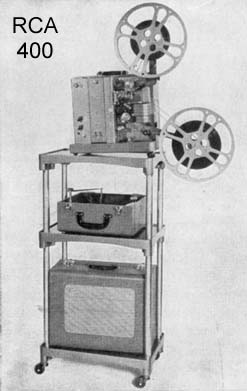
Projectors
Personally I use Bell and Howell 1500 and 2500 series projectors
because they are more plentiful and therefore cheaper.
Accessories and special lenses are easier to find. The older Bell
and Howells (100 to 500 series) use conventional lamps and are not as
efficient. The 100 to 500 series also have vacuum tube
amplifiers. The 202 and 302 were the most common models with
magnetic sound. Nearly all Bell and Howell models are capable of
running at either sound speed (24 fps) or silent speed (16 to 18
fps). If you use a self-threading model, be sure to replace
twisted shrunken plastic leaders with good new leader for reliable
threading. Click here for a chart
comparing all known Bell and Howell 16 mm projector models.
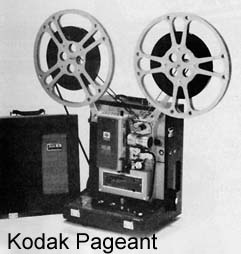
Many people prefer Eiki and Elmo projectors, as they are newer and run
slightly quieter. They typically cost a little more, special
lenses are hard to find, and most don't run at silent speed. The
Eikis have a reputation for being easy to work on, and Elmos are smooth
running. Many like the Kodak, which is considered very gentle on
film, but difficult to repair. The older Kodaks use the
less-efficient tubular lamps, and the last models used halogen
lamps. Special lenses are particularly
hard to find for Elmo and Kodak.
Copyright 2005, Paul Ivester. May be reproduced for personal use
only .
 Return to Paul's projector page.
Return to Paul's projector page.
 Return to
Paul's main film page.
Return to
Paul's main film page.






















 Return to Paul's projector page.
Return to Paul's projector page. Return to
Paul's main film page.
Return to
Paul's main film page.